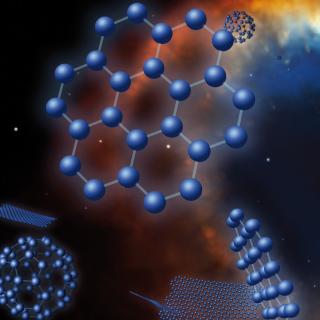Bibcode
Sarkar, G.; García-Hernández, D. A.; Parthasarathy, M.; Manchado, A.; García-Lario, P.; Takeda, Y.
Referencia bibliográfica
Monthly Notices of the Royal Astronomical Society, Volume 421, Issue 1, pp. 679-699.
Fecha de publicación:
3
2012
Número de citas
14
Número de citas referidas
14
Descripción
The first high-resolution (R˜ 50 000) optical spectrum of the
B-type star, LS III +52°24, identified as the optical counterpart of
the hot post-asymptotic giant branch (post-AGB) candidate IRAS
22023+5249 (I22023) is presented. We report the detailed identifications
of the observed absorption and emission features in the full wavelength
range (4290-9015 Å) as well as the atmospheric parameters and
photospheric abundances (under the local thermodynamic equilibrium
approximation) for the first time. The nebular parameters
(Te, Ne) are also derived. We estimate
Teff= 24 000 K, log g= 3.0 and ξt= 7 km
s-1, and the derived abundances indicate a slightly
metal-deficient evolved star with C/O < 1. The observed P-Cygni
profiles of hydrogen and helium clearly indicate ongoing post-AGB
mass-loss. The presence of [N II] and [S II] lines and the non-detection
of [O III] indicate that photoionization has just started. The observed
spectral features, large heliocentric radial velocity, atmospheric
parameters and chemical composition indicate that I22023 is an evolved
post-AGB star belonging to the old disc population. The derived nebular
parameters (Te= 7000 K, Ne= 1.2 ×
104 cm-3) also suggest that I22023 may be evolving
into a compact, young low-excitation planetary nebula. Our optical
spectroscopic analysis together with the recent Spitzer detection of
double-dust chemistry (the simultaneous presence of carbonaceous
molecules and amorphous silicates) in I22023 and other B-type post-AGB
candidates may point to a binary system with a dusty disc as the stellar
origin common to the hot post-AGB stars with O-rich central stars.
Proyectos relacionados

Nucleosíntesis y procesos moleculares en los últimos estados de la evolución estelar
Las estrellas de masa baja e intermedia (M < 8 masas solares, Ms) representan la mayoría de estrellas en el Cosmos y terminan sus vidas en la Rama Asintótica de las Gigantes (AGB) - justo antes de formar Nebulosas Planetarias (NPs) - cuando experimentan procesos nucleosintéticos y moleculares complejos. Las estrellas AGB son importantes
Domingo Aníbal
García Hernández